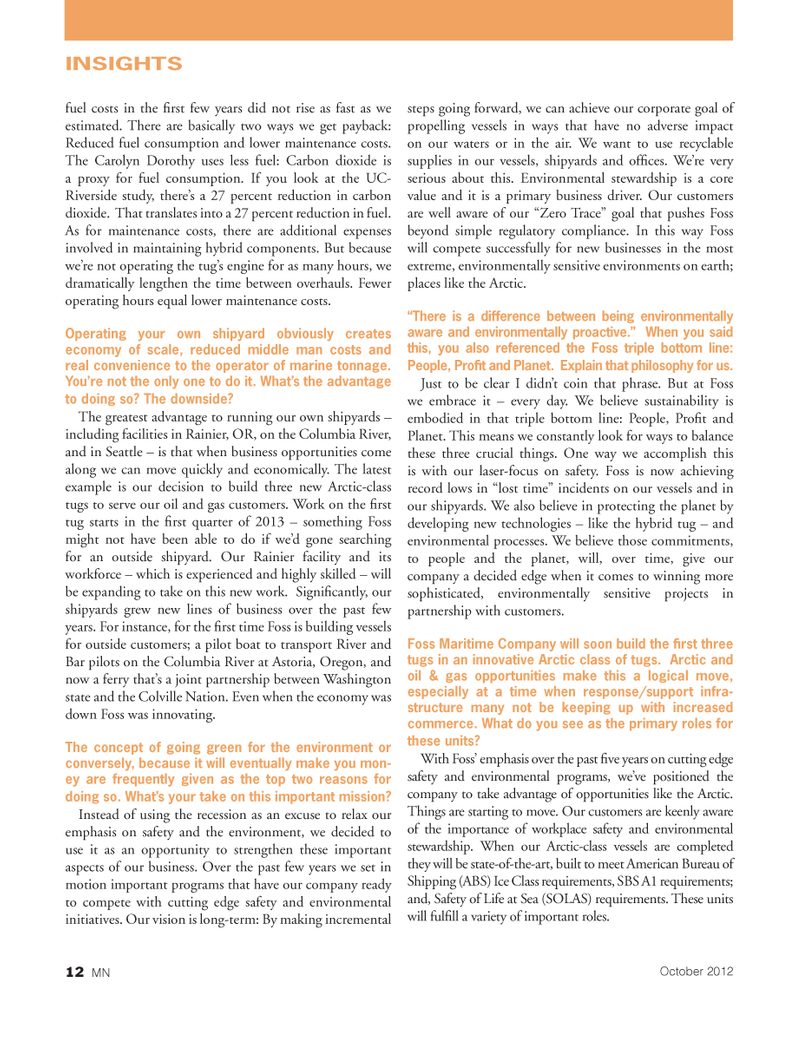
Page 12: of Marine News Magazine (October 2012)
Year in Review & Leadership
Read this page in Pdf, Flash or Html5 edition of October 2012 Marine News Magazine
INSIGHTSfuel costs in the Þ rst few years did not rise as fast as we estimated. There are basically two ways we get payback: Reduced fuel consumption and lower maintenance costs. The Carolyn Dorothy uses less fuel: Carbon dioxide is a proxy for fuel consumption. If you look at the UC- Riverside study, thereÕs a 27 percent reduction in carbon dioxide. That translates into a 27 percent reduction in fuel. As for maintenance costs, there are additional expenses involved in maintaining hybrid components. But because weÕre not operating the tugÕs engine for as many hours, we dramatically lengthen the time between overhauls. Fewer operating hours equal lower maintenance costs. Operating your own shipyard obviously creates economy of scale, reduced middle man costs and real convenience to the operator of marine tonnage. You?re not the only one to do it. What?s the advantage to doing so? The downside?The greatest advantage to running our own shipyards Ð including facilities in Rainier, OR, on the Columbia River, and in Seattle Ð is that when business opportunities come along we can move quickly and economically. The latest example is our decision to build three new Arctic-class tugs to serve our oil and gas customers. Work on the Þ rst tug starts in the Þ rst quarter of 2013 Ð something Foss might not have been able to do if weÕd gone searching for an outside shipyard. Our Rainier facility and its workforce Ð which is experienced and highly skilled Ð will be expanding to take on this new work. SigniÞ cantly, our shipyards grew new lines of business over the past few years. For instance, for the Þ rst time Foss is building vessels for outside customers; a pilot boat to transport River and Bar pilots on the Columbia River at Astoria, Oregon, and now a ferry thatÕs a joint partnership between Washington state and the Colville Nation. Even when the economy was down Foss was innovating. The concept of going green for the environment or conversely, because it will eventually make you mon- ey are frequently given as the top two reasons for doing so. What?s your take on this important mission? Instead of using the recession as an excuse to relax our emphasis on safety and the environment, we decided to use it as an opportunity to strengthen these important aspects of our business. Over the past few years we set in motion important programs that have our company ready to compete with cutting edge safety and environmental initiatives. Our vision is long-term: By making incremental steps going forward, we can achieve our corporate goal of propelling vessels in ways that have no adverse impact on our waters or in the air. We want to use recyclable supplies in our vessels, shipyards and ofÞ ces. WeÕre very serious about this. Environmental stewardship is a core value and it is a primary business driver. Our customers are well aware of our ÒZero TraceÓ goal that pushes Foss beyond simple regulatory compliance. In this way Foss will compete successfully for new businesses in the most extreme, environmentally sensitive environments on earth; places like the Arctic. ?There is a difference between being environmentally aware and environmentally proactive.? When you said this, you also referenced the Foss triple bottom line: People, Pro t and Planet. Explain that philosophy for us. Just to be clear I didnÕt coin that phrase. But at Foss we embrace it Ð every day. We believe sustainability is embodied in that triple bottom line: People, ProÞ t and Planet. This means we constantly look for ways to balance these three crucial things. One way we accomplish this is with our laser-focus on safety. Foss is now achieving record lows in Òlost timeÓ incidents on our vessels and in our shipyards. We also believe in protecting the planet by developing new technologies Ð like the hybrid tug Ð and environmental processes. We believe those commitments, to people and the planet, will, over time, give our company a decided edge when it comes to winning more sophisticated, environmentally sensitive projects in partnership with customers. Foss Maritime Company will soon build the rst three tugs in an innovative Arctic class of tugs. Arctic and oil & gas opportunities make this a logical move, especially at a time when response/support infra- structure many not be keeping up with increased commerce. What do you see as the primary roles for these units? With FossÕ emphasis over the past Þ ve years on cutting edge safety and environmental programs, weÕve positioned the company to take advantage of opportunities like the Arctic. Things are starting to move. Our customers are keenly aware of the importance of workplace safety and environmental stewardship. When our Arctic-class vessels are completed they will be state-of-the-art, built to meet American Bureau of Shipping (ABS) Ice Class requirements, SBS A1 requirements; and, Safety of Life at Sea (SOLAS) requirements. These units will fulÞ ll a variety of important roles. 12 MNOctober 2012MNOct2012 Layout 1-17.indd 12MNOct2012 Layout 1-17.indd 1210/2/2012 9:32:16 AM10/2/2012 9:32:16 AM

 11
11

 13
13
